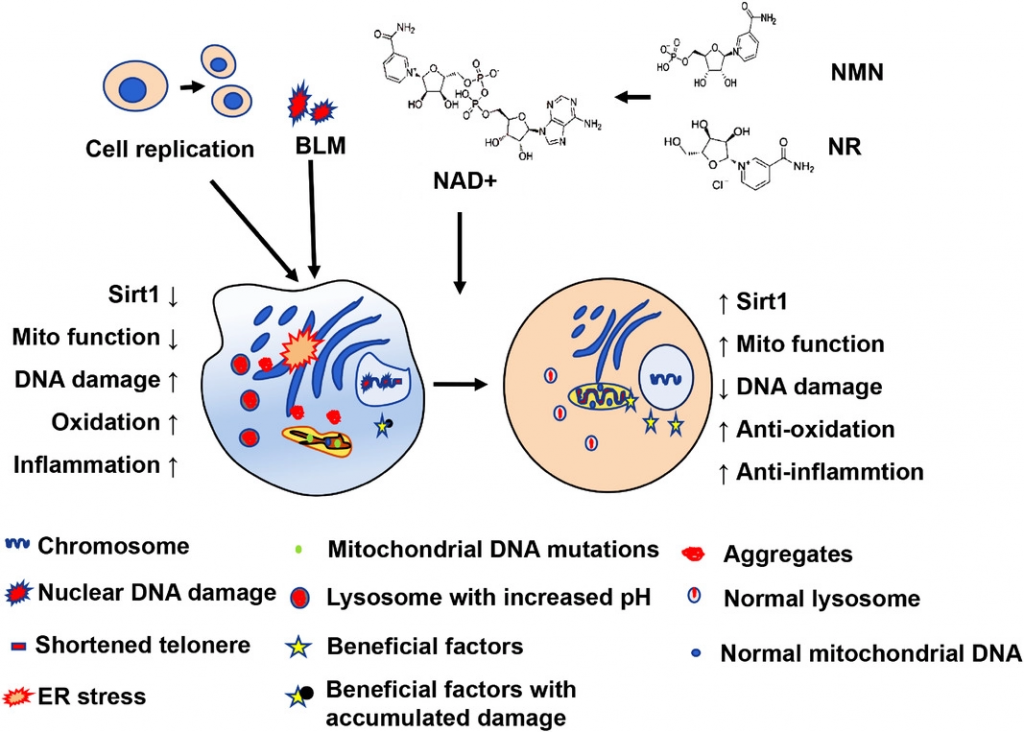Highlights
- Senescence of lung cells called alveolar epithelial cells — critical for getting oxygen into the body — is alleviated by the NAD+ precursor NMN.
- The addition of NMN can effectively alleviate injury-induced senescence in lung cells from mice.
Through breathing, we bring in oxygen, needed by all cells in our body to make energy, from the air and into our bloodstream. After oxygen-rich air gets pulled into our lungs, it has to make its way through a lining made up of alveolar epithelial cells (AECs). However, aging shuts these cells down, locking them in a non-replicative state called senescence, which drives a decline in breathing abilities.
In an article published in MedComm, Fang and colleagues showed that nicotinamide mononucleotide (NMN) — a precursor to another requisite molecule to all cells NAD+ — could effectively alleviate the senescence of AECs in mice. The researchers from West China Hospital Sichuan University in Chengdu, China, showed that NMN could effectively mitigate injury-induced decline in the lungs of mice. This study suggests that NMN supplementation is a preventive and therapeutic approach for aging-related chronic lung diseases and lung injury caused by external stimuli in the future.
Alveolar epithelial cells are necessary for the breath of life
AECs constitute 99% of the surface area of the lung, playing major roles in lung functions. In addition to serving as a barrier between the environment and the body, AECs play a critical role in gas exchange — in this case, the intake of oxygen and release of carbon dioxide — and immune responses. The senescence of these cells is the main reason for the decline of lung function in aging. Although AECs senescence is of great significance for the study of senescence-related chronic lung diseases, its specific mechanism and role are still not fully understood.
The declining function of various tissues and organs of the body with aging is accompanied by a decrease in cell levels of NAD+, including the lungs. Boosting NAD+ — which has an indispensable hand in hundreds of vital cell processes — boosting through supplementation of precursors like NMN is reported to affect the development and presentation of many aging-related diseases, such as neurodegenerative diseases. But, there has been little investigative work on the effects of NAD+ precursors on pulmonary aging and AECs senescence.
NMN ameliorates senescence in alveolar epithelial cells
Fang and colleagues administered NMN to mice aged 8 to 10 months at a dosage of 500 mg/kg/day for two months. After that, they examined the lungs of these mice for signs of aging, as determined by levels of senescent markers p16 and p21. They found that these aging-related proteins, which inhibit the cell cycle, were significantly reduced in mice treated with NMN via drinking water or direct oral administration. The levels of lung cell senescence in NMN treated mice were similar to that of young mice (6 to 8 weeks), suggesting that NMN reduces senescence in aged mouse lungs.
Evidence shows that the scarring of lung tissue (pulmonary fibrosis) is based on the induction of AEC senescence, thereby damaging the regenerative capacity of the lung lining. Using a toxin called bleomycin to induce pulmonary fibrosis, Fang and colleagues examined the effect of NMN at a dose of 500 mg/kg/day on lung cell senescence. In mice only treated with bleomycin, they detected senescence-related indicators after three weeks. But in mice orally administered NMN, the levels of these senescent markers decreased, and the lung’s appearance significantly improved. Also, NMN alleviated the destruction of alveoli and the infiltration of inflammatory immune cells.

Since the experiments in mice cannot distinguish between the types of lung cells, Fang and colleagues repeated these experiments in extracted and cultured AECs to examine if NMN affected the senescence of these specific cells. Similar to the data in lung tissue, the researchers found that NMN could effectively alleviate both replicative- and bleomycin-induced senescence. These findings suggest that NMN can effectively alleviate BLM-induced lung primary cell senescence.

How does NMN improve lung senescence?
Aging is a complex process, and many factors lead to cell senescence, such as genome instability, oxidative stress, and mitochondrial dysfunction. To this end, the research presented here did not comprehensively study how NMN prevents aging of the lung and AECs. Other research has shown that NMN supplementation decreases oxidative stress in cells and reduces the damage of cellular function induced by oxidative stress. For example, studies have shown that NMN can improve genetic instability, mitochondrial function, and the activity of enzymes dependent on NAD+.
If these data translate to humans, the question will remain as to how to administer NMN best to increase the levels of NAD+ in AECs. That being said, whether NMN can be directly administered to the lungs by being incorporated into a nasal spray has yet to be determined.
